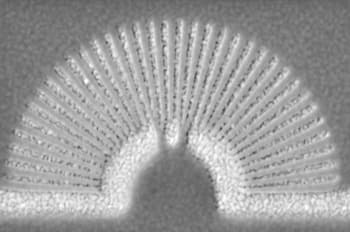Slinky-Like Metamaterial Hyperlens May Help Detect Cancer Someday
Researchers have been using the technological ability to see really tiny objects for advancing the fields of medical science (detect cancer) as well as electronics (nanotechnology). In a new research work conducted by the engineers at University of Buffalo, a new metamaterial hyperlens has been developed that looks like the Slinky we all have played with as kids. It is now being said that this technology can be used to build the world's most powerful optical system in future cameras and microscopes. Traditional systems are troubled by diffraction which set a limit to the resolution of optical systems. With a metamaterial having properties not yet found in nature, engineers hope to build hyperlenses that overcome the limit by converting decaying evanescent waves into propagating waves.


Slinky
Replacing rings of silver and dielectric with gold and PMMA (a transparent thermoplastic), the Slinky-shaped metamaterial hyperlenses could overcome the diffraction limit in visible frequency range that could be integrated with an optical waveguide.
This phenomenon makes it possible to develop hyperlens-based medical endoscopes to at least 250 nanometers. The tech also finds application in the field of optical nanolithography for building next-gen storage drives, sensors and other optoelectronic devices.
The fields of chemistry and biology could also benefit from the metamaterial hyperlens as it hold promise in sequencing single molecules.
What are your thoughts about the slink-look-alike hyperlens? Share with us in comments below.
Source: <a href="https://www.buffalo.edu/news/releases/2015/05/039.html" target="_blank" rel="noopener noreferrer">This Slinky lookalike “hyperlens” helps us see tiny objects - University at Buffalo</a>


Slinky
Replacing rings of silver and dielectric with gold and PMMA (a transparent thermoplastic), the Slinky-shaped metamaterial hyperlenses could overcome the diffraction limit in visible frequency range that could be integrated with an optical waveguide.
This phenomenon makes it possible to develop hyperlens-based medical endoscopes to at least 250 nanometers. The tech also finds application in the field of optical nanolithography for building next-gen storage drives, sensors and other optoelectronic devices.
The fields of chemistry and biology could also benefit from the metamaterial hyperlens as it hold promise in sequencing single molecules.
What are your thoughts about the slink-look-alike hyperlens? Share with us in comments below.
Source: <a href="https://www.buffalo.edu/news/releases/2015/05/039.html" target="_blank" rel="noopener noreferrer">This Slinky lookalike “hyperlens” helps us see tiny objects - University at Buffalo</a>
0
